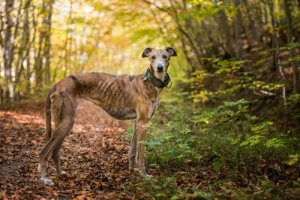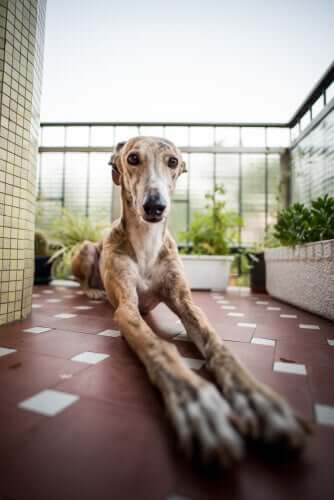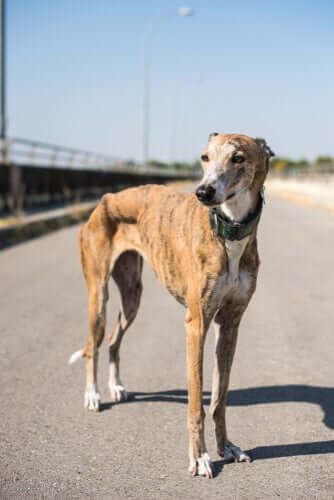Meet the Greyhound: A True Racing Dog

The greyhound, also known as the English greyhound, is one of the fastest dog breeds on the planet. Its speed has been recognized for centuries and this gave it a privileged position among high society. Today, we’re going to talk about the most important aspects of this amazing dog.
The greyhound and its origins
The origin of these dogs is unclear. Experts say they arrived in the British Isles during the 10th or 11th century, but this fact isn’t certain. What is certain though, is that the Celts, through their migratory journeys, brought this breed with them as they settled in the region.
After this, the greyhounds began to increasingly occupy higher positions in British societies: it was forbidden for a peasant to have a greyhound because the nobility classified them as a high lineage dog.
This was probably due to the fact that these animals’ ancestors were used as pets by the ancient Egyptian pharaohs. Egyptians engraved images of this dog breed in hieroglyphs inside the region’s pyramids. These pictographs are very similar and resemble our current day greyhound dogs.
Wherever they may come from, these dogs have become famous for their speed. Moreover, the dog can reach a running top speed of 41 mph, only surpassed by cheetahs and racehorses. In addition, greyhound racing is one of the most popular sports in the world today.
Physical aspects and appearance
Although they don’t look very robust, these dogs have great skills that make them look like a gazelle when running.
Head
- Greyhounds have elongated heads with fine features and their snouts are articulate and scissor-shaped.
- Their teeth fit perfectly together.
- Their eyes have little separation between them. As a result, some people believe they have a serious look.
- Their ears are on top of their heads, are medium-sized, and hang down to the level of the muzzle.
Body
- They possess elongated bodies that grant them more speed.
- They’re slender in appearance, with exposed large muscles.
- The stomach may look sunken, but this is due to the body’s shape and is just an impression.
- Its limbs are long and powerful, possessing great agility and the ability to make sudden turns while running.
- They have a long tail that curls between the hind legs most of the time.
- Its coat is short and fine and has grey, brown, and black colors, with no spots. A brindle color pattern is also common.
Temperament
The greyhound has a very keen hunting instinct, and can become stubborn and almost indomitable in most cases. For this reason, it isn’t a recommended dog breed for first-time trainers, as they can be very temperamental.

Under a steady hand’s tutelage, this breed can become the ideal pet. It usually likes to sleep on the couch during its downtime and loves playing catch with anything thrown at it. This kind of exercise is ideal for them since it will help burn their energy, satisfy their primary instinct, and prevent unwanted behavior.
If you live with other small pets, it’s important that you teach them as much obedience as possible. As they have been hunting dogs for ages, they do need some training. Otherwise, it’s possible the dog may end up hurting the other pets and even have them for dinner!
With a lot of effort, the greyhound can become the ideal pet to have at home. To do this, we recommend training the puppy with obedience exercises, introducing it to other people and animals in an appropriate way. Last but not least, providing it with all the necessary running and speed activities is also crucial.
Health and diseases
This is a fairly healthy breed and normally doesn’t have any serious diseases. However, despite their high speed, the greyhound is not exempt from diseases that can eventually catch up with them.
Some of these diseases can become quite serious if they’re not treated in time. Stomach twisting is quite common, as is retinal atrophy.
Moreover, some specimens are highly sensitive to chemicals. Therefore, if you have a dog of this breed, keep these products away from it: insecticides, flea collars, feal sprays, especially if these contain pyrethrin.

Aside from this, the greyhound is a dog that has few healthcare needs. It’s very resistant in spite of its small but flexible body. A weekly brush will remove the dead hair from its coat, and a visit to the vet every six months is a good idea.
If you walk it a lot in the countryside, you must be very careful with its coat, as it can pick up parasites such as ticks that can transmit blood diseases.
As far as bathing is concerned, you should only give it one when you think it’s necessary. Its short coat already prevents it from accumulating excess dirt.
Many dog experts have published guides and books to help greyhound owners to accommodate their dog in their new home. We hope you found this article useful, until next time!
The greyhound, also known as the English greyhound, is one of the fastest dog breeds on the planet. Its speed has been recognized for centuries and this gave it a privileged position among high society. Today, we’re going to talk about the most important aspects of this amazing dog.
The greyhound and its origins
The origin of these dogs is unclear. Experts say they arrived in the British Isles during the 10th or 11th century, but this fact isn’t certain. What is certain though, is that the Celts, through their migratory journeys, brought this breed with them as they settled in the region.
After this, the greyhounds began to increasingly occupy higher positions in British societies: it was forbidden for a peasant to have a greyhound because the nobility classified them as a high lineage dog.
This was probably due to the fact that these animals’ ancestors were used as pets by the ancient Egyptian pharaohs. Egyptians engraved images of this dog breed in hieroglyphs inside the region’s pyramids. These pictographs are very similar and resemble our current day greyhound dogs.
Wherever they may come from, these dogs have become famous for their speed. Moreover, the dog can reach a running top speed of 41 mph, only surpassed by cheetahs and racehorses. In addition, greyhound racing is one of the most popular sports in the world today.
Physical aspects and appearance
Although they don’t look very robust, these dogs have great skills that make them look like a gazelle when running.
Head
- Greyhounds have elongated heads with fine features and their snouts are articulate and scissor-shaped.
- Their teeth fit perfectly together.
- Their eyes have little separation between them. As a result, some people believe they have a serious look.
- Their ears are on top of their heads, are medium-sized, and hang down to the level of the muzzle.
Body
- They possess elongated bodies that grant them more speed.
- They’re slender in appearance, with exposed large muscles.
- The stomach may look sunken, but this is due to the body’s shape and is just an impression.
- Its limbs are long and powerful, possessing great agility and the ability to make sudden turns while running.
- They have a long tail that curls between the hind legs most of the time.
- Its coat is short and fine and has grey, brown, and black colors, with no spots. A brindle color pattern is also common.
Temperament
The greyhound has a very keen hunting instinct, and can become stubborn and almost indomitable in most cases. For this reason, it isn’t a recommended dog breed for first-time trainers, as they can be very temperamental.

Under a steady hand’s tutelage, this breed can become the ideal pet. It usually likes to sleep on the couch during its downtime and loves playing catch with anything thrown at it. This kind of exercise is ideal for them since it will help burn their energy, satisfy their primary instinct, and prevent unwanted behavior.
If you live with other small pets, it’s important that you teach them as much obedience as possible. As they have been hunting dogs for ages, they do need some training. Otherwise, it’s possible the dog may end up hurting the other pets and even have them for dinner!
With a lot of effort, the greyhound can become the ideal pet to have at home. To do this, we recommend training the puppy with obedience exercises, introducing it to other people and animals in an appropriate way. Last but not least, providing it with all the necessary running and speed activities is also crucial.
Health and diseases
This is a fairly healthy breed and normally doesn’t have any serious diseases. However, despite their high speed, the greyhound is not exempt from diseases that can eventually catch up with them.
Some of these diseases can become quite serious if they’re not treated in time. Stomach twisting is quite common, as is retinal atrophy.
Moreover, some specimens are highly sensitive to chemicals. Therefore, if you have a dog of this breed, keep these products away from it: insecticides, flea collars, feal sprays, especially if these contain pyrethrin.

Aside from this, the greyhound is a dog that has few healthcare needs. It’s very resistant in spite of its small but flexible body. A weekly brush will remove the dead hair from its coat, and a visit to the vet every six months is a good idea.
If you walk it a lot in the countryside, you must be very careful with its coat, as it can pick up parasites such as ticks that can transmit blood diseases.
As far as bathing is concerned, you should only give it one when you think it’s necessary. Its short coat already prevents it from accumulating excess dirt.
Many dog experts have published guides and books to help greyhound owners to accommodate their dog in their new home. We hope you found this article useful, until next time!
This text is provided for informational purposes only and does not replace consultation with a professional. If in doubt, consult your specialist.








